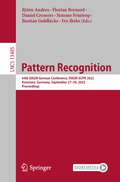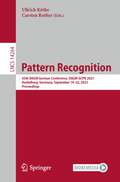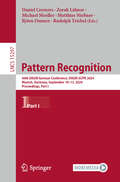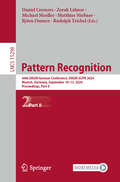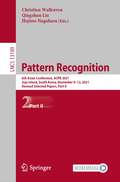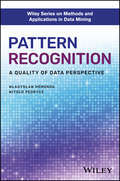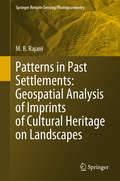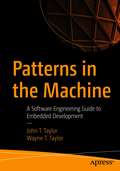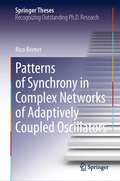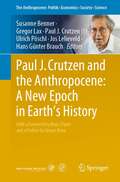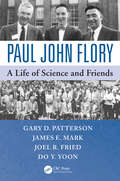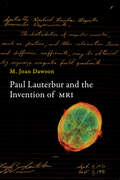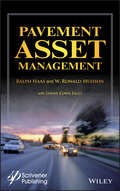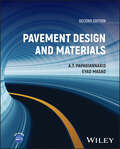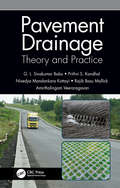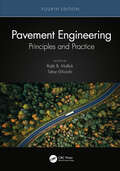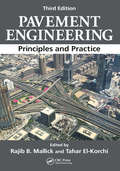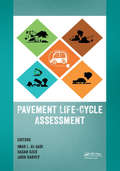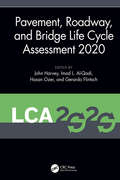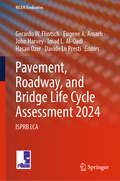- Table View
- List View
Pattern Recognition: 44th DAGM German Conference, DAGM GCPR 2022, Konstanz, Germany, September 27–30, 2022, Proceedings (Lecture Notes in Computer Science #13485)
by Daniel Cremers Simone Frintrop Björn Andres Florian Bernard Bastian Goldlücke Ivo IhrkeThis book constitutes the refereed proceedings of the 44th DAGM German Conference on Pattern Recognition, DAGM GCPR 2022, which was held during September 27 – 30, 2022.The 37 papers presented in this volume were carefully reviewed and selected from 78 submissions. They were organized in topical sections as follows: machine learning methods; unsupervised, semi-supervised and transfer learning; interpretable machine learning; low-level vision and computational photography; motion, pose estimation and tracking; 3D vision and stereo; detection and recognition; language and vision; scene understanding; photogrammetry and remote sensing; pattern recognition in the life and natural sciences; systems and applications.
Pattern Recognition: 45th DAGM German Conference, DAGM GCPR 2023, Heidelberg, Germany, September 19–22, 2023, Proceedings (Lecture Notes in Computer Science #14264)
by Carsten Rother Ullrich KötheThis book constitutes the proceedings of the 45th Annual Conference of the German Association for Pattern Recognition, DAGM-GCPR 2023, which took place in Heidelberg, Germany, during September 19-22, 2023. The 40 full papers included in these proceedings were carefully reviewed and selected from 76 submissions. They were organized in topical sections as follows: Segmentation and action recognition; 3D reconstruction and neural rendering; Photogrammetry and remote sensing; Pattern recognition in the life sciences; Interpretable machine learning; Weak supervision and online learning; Robust models.
Pattern Recognition: 46th DAGM German Conference, DAGM GCPR 2024, Munich, Germany, September 10–13, 2024, Proceedings, Part I (Lecture Notes in Computer Science #15297)
by Daniel Cremers Zorah Lähner Michael Moeller Matthias Nießner Björn Ommer Rudolph TriebelThis 2-volume set LNCS 15297-15298 constitutes the refereed proceedings of the 46th Annual Conference of the German Association for Pattern Recognition, DAGM-GCPR 2024, held in Munich, Germany, during September 10-13, 2024.The 44 full papers included in these proceedings were carefully reviewed and selected from 81 submissions. They are organized in these topical sections:Part I: Clustering and Segmentation; Learning Techniques; Medical and Biological Applications; Uncertainty and Explainability.Part II: Modelling of Faces and Shapes; Image Generation and Reconstruction; 3D Analysis and Sythesis; Video Analysis; Photogrammetry and Remote Sensing.
Pattern Recognition: 46th DAGM German Conference, DAGM GCPR 2024, Munich, Germany, September 10–13, 2024, Proceedings, Part II (Lecture Notes in Computer Science #15298)
by Daniel Cremers Zorah Lähner Michael Moeller Matthias Nießner Björn Ommer Rudolph TriebelThis 2-volume set LNCS 15297-15298 constitutes the refereed proceedings of the 46th Annual Conference of the German Association for Pattern Recognition, DAGM-GCPR 2024, held in Munich, Germany, during September 10-13, 2024.The 44 full papers included in these proceedings were carefully reviewed and selected from 81 submissions. They are organized in these topical sections:Part I: Clustering and Segmentation; Learning Techniques; Medical and Biological Applications; Uncertainty and Explainability.Part II: Modelling of Faces and Shapes; Image Generation and Reconstruction; 3D Analysis and Sythesis; Video Analysis; Photogrammetry and Remote Sensing.
Pattern Recognition: 5th Asian Conference, ACPR 2019, Auckland, New Zealand, November 26–29, 2019, Revised Selected Papers, Part I (Lecture Notes in Computer Science #12046)
by Liang Wang Wei Qi Yan Shivakumara Palaiahnakote Gabriella Sanniti di BajaThis two-volume set constitutes the proceedings of the 5th Asian Conference on ACPR 2019, held in Auckland, New Zealand, in November 2019. The 9 full papers presented in this volume were carefully reviewed and selected from 14 submissions. They cover topics such as: classification; action and video and motion; object detection and anomaly detection; segmentation, grouping and shape; face and body and biometrics; adversarial learning and networks; computational photography; learning theory and optimization; applications, medical and robotics; computer vision and robot vision; pattern recognition and machine learning; multi-media and signal processing; and interaction.
Pattern Recognition: 6th Asian Conference, ACPR 2021, Jeju Island, South Korea, November 9–12, 2021, Revised Selected Papers, Part II (Lecture Notes in Computer Science #13189)
by Qingshan Liu Christian Wallraven Hajime NagaharaThis two-volume set LNCS 13188 - 13189 constitutes the refereed proceedings of the 6th Asian Conference on Pattern Recognition, ACPR 2021, held in Jeju Island, South Korea, in November 2021. The 85 full papers presented were carefully reviewed and selected from 154 submissions. The papers are organized in topics on: classification, action and video and motion, object detection and anomaly, segmentation, grouping and shape, face and body and biometrics, adversarial learning and networks, computational photography, learning theory and optimization, applications, medical and robotics, computer vision and robot vision.
Pattern Recognition: A Quality of Data Perspective
by Witold Pedrycz Wladyslaw HomendaA new approach to the issue of data quality in pattern recognition Detailing foundational concepts before introducing more complex methodologies and algorithms, this book is a self-contained manual for advanced data analysis and data mining. Top-down organization presents detailed applications only after methodological issues have been mastered, and step-by-step instructions help ensure successful implementation of new processes. By positioning data quality as a factor to be dealt with rather than overcome, the framework provided serves as a valuable, versatile tool in the analysis arsenal. For decades, practical need has inspired intense theoretical and applied research into pattern recognition for numerous and diverse applications. Throughout, the limiting factor and perpetual problem has been data—its sheer diversity, abundance, and variable quality presents the central challenge to pattern recognition innovation. Pattern Recognition: A Quality of Data Perspective repositions that challenge from a hurdle to a given, and presents a new framework for comprehensive data analysis that is designed specifically to accommodate problem data. Designed as both a practical manual and a discussion about the most useful elements of pattern recognition innovation, this book: Details fundamental pattern recognition concepts, including feature space construction, classifiers, rejection, and evaluation Provides a systematic examination of the concepts, design methodology, and algorithms involved in pattern recognition Includes numerous experiments, detailed schemes, and more advanced problems that reinforce complex concepts Acts as a self-contained primer toward advanced solutions, with detailed background and step-by-step processes Introduces the concept of granules and provides a framework for granular computing Pattern recognition plays a pivotal role in data analysis and data mining, fields which are themselves being applied in an expanding sphere of utility. By facing the data quality issue head-on, this book provides students, practitioners, and researchers with a clear way forward amidst the ever-expanding data supply.
Pattern Theory: The Stochastic Analysis of Real-World Signals
by David Mumford Agnès DesolneuxPattern theory is a distinctive approach to the analysis of all forms of real-world signals. At its core is the design of a large variety of probabilistic models whose samples reproduce the look and feel of the real signals, their patterns, and their variability. Bayesian statistical inference then allows you to apply these models in the analysis o
Patterns in Past Settlements: Geospatial Analysis of Imprints of Cultural Heritage on Landscapes (Springer Remote Sensing/Photogrammetry)
by M.B. RajaniThis book is an introduction to a new branch of archaeology that scrutinises landscapes to find evidence of past human activity. Such evidence can be hard to detect at ground-level, but may be visible in remote sensing (RS) imagery from aerial platforms and satellites. Drawing on examples from around the world as well as from her own research work on archaeological sites in India (including Nalanda, Agra, Srirangapatna, Talakadu, and Mahabalipuram), the author presents a systematic process for integrating this information with historical spatial records such as old maps, paintings, and field surveys using Geographic Information Systems (GIS) to gain new insights into our past. Further, the book highlights several instances where these insights are actionable -- they have been used to identify, understand, conserve, and protect the fragile remnants of our past. This book will be of particular interest not only to researchers in archaeology, history, art history, and allied fields, but to governmental and non-governmental professionals working in cultural heritage protection and conservation.
Patterns in the Machine: A Software Engineering Guide to Embedded Development
by John T. Taylor Wayne T. TaylorDiscover how to apply software engineering patterns to develop more robust firmware faster than traditional embedded development approaches. In the authors’ experience, traditional embedded software projects tend towards monolithic applications that are optimized for their target hardware platforms. This leads to software that is fragile in terms of extensibility and difficult to test without fully integrated software and hardware. Patterns in the Machine focuses on creating loosely coupled implementations that embrace both change and testability. This book illustrates how implementing continuous integration, automated unit testing, platform-independent code, and other best practices that are not typically implemented in the embedded systems world is not just feasible but also practical for today’s embedded projects. After reading this book, you will have a better idea of how to structure your embedded software projects. You will recognize that while writing unit tests, creating simulators, and implementing continuous integration requires time and effort up front, you will be amply rewarded at the end of the project in terms of quality, adaptability, and maintainability of your code. What You Will Learn Incorporate automated unit testing into an embedded projectDesign and build functional simulators for an embedded projectWrite production-quality software when hardware is not availableUse the Data Model architectural pattern to create a highly decoupled design and implementationUnderstand the importance of defining the software architecture before implementation starts and how to do itDiscover why documentation is essential for an embedded projectUse finite state machines in embedded projects Who This Book Is For Mid-level or higher embedded systems (firmware) developers, technical leads, software architects, and development managers.
Patterns of Interaction: Computational Design Across Scales (SpringerBriefs in Architectural Design and Technology)
by Pia Fricker Toni KotnikThis book is a reflection on contemporary computational design thinking at the intersection of architecture, urban design, and landscape architecture, in a time marked by complex challenges like climate change, urbanization and population growth. Based on a critical rethinking of the notion of ground and the relation between the manmade and the natural environment, an understanding of architecture as regenerative practice is proposed. It aims at a built environment as landscape, at an architecture of prosthetic nature. The design approach is illustrated by a number of design experiments conducted within a studio setting and complemented by a series of conversations with leading experts on sustainable design and landscape architecture.
Patterns of Synchrony in Complex Networks of Adaptively Coupled Oscillators (Springer Theses)
by Rico BernerThe focus of this thesis is the interplay of synchrony and adaptivity in complex networks. Synchronization is a ubiquitous phenomenon observed in different contexts in physics, chemistry, biology, neuroscience, medicine, socioeconomic systems, and engineering. Most prominently, synchronization takes place in the brain, where it is associated with cognitive capacities like learning and memory, but is also a characteristic of neurological diseases like Parkinson and epilepsy. Adaptivity is common in many networks in nature and technology, where the connectivity changes in time, i.e., the strength of the coupling is continuously adjusted depending upon the dynamic state of the system, for instance synaptic neuronal plasticity in the brain. This research contributes to a fundamental understanding of various synchronization patterns, including hierarchical multifrequency clusters, chimeras and other partial synchronization states. After a concise survey of the fundamentals of adaptive and complex dynamical networks and synaptic plasticity, in the first part of the thesis the existence and stability of cluster synchronization in globally coupled adaptive networks is discussed for simple paradigmatic phase oscillators as well as for a more realistic neuronal oscillator model with spike-timing dependent plasticity. In the second part of the thesis the interplay of adaptivity and connectivity is investigated for more complex network structures like nonlocally coupled rings, random networks, and multilayer systems. Besides presenting a plethora of novel, sometimes intriguing patterns of synchrony, the thesis makes a number of pioneering methodological advances, where rigorous mathematical proofs are given in the Appendices. These results are of interest not only from a fundamental point of view, but also with respect to challenging applications in neuroscience and technological systems.
Paul B. Thompson's Philosophy of Agriculture: Fields, Farmers, Forks, and Food (The International Library of Environmental, Agricultural and Food Ethics #34)
by Zachary Piso Samantha NollThis book explores the philosophical thought and praxis of Paul B. Thompson, who planted some of the first seeds of philosophy of agriculture and whose work inspires interdisciplinary scholarship in food ethics, biotechnology, and environmental philosophy. Landmark texts such as The Spirit of the Soil, The Agrarian Vision, and From Field to Fork revealed the fertility of food systems for inspiring reflection on our relationships to technology, the land, and one another. Rooted in philosophical traditions ranging from pragmatism to post-phenomenology, Thompson’s work nourishes projects in ethics, epistemology, philosophy of science, and social and political theory, not only in academic philosophy departments but also in the social and natural sciences. This volume collects this diversity of thought in a tour of the many fields of food systems; from theorizing the sustainability of agroecological systems, to appreciating the quotidian practice of agrarian communities, to anticipating the impacts of emerging biotechnology, and to savoring the roles that food plays in forming our identities. Composed by an international crop of scholars working on the future of food ethics, the volume is a vital contribution to scholars and practitioners thinking through our relationships to the food systems that sustain us.
Paul J. Crutzen and the Anthropocene: A New Epoch in Earth’s History (The Anthropocene: Politik—Economics—Society—Science #1)
by Hans Günter Brauch Paul J. Crutzen Susanne Benner Gregor Lax Ulrich Pöschl Jos LelieveldThis book outlines the development and perspectives of the Anthropocene concept by Paul J. Crutzen and his colleagues from its inception to its implications for the sciences, humanities, society and politics.The main text consists primarily of articles from peer-reviewed scientific journals and other scholarly sources. It comprises selected articles on the Anthropocene published by Paul J. Crutzen and a selection of related articles, mostly but not exclusively by colleagues with whom he collaborated closely.• In the year 2000 Nobel Laureate Paul J. Crutzen proposed the Anthropocene concept as a new epoch in Earth’s history • Comprehensive collection of articles on the Anthropocene by Paul J. Crutzen and his colleagues• Unique primary research literature and Crutzen’s comprehensive bibliography• Paul Crutzen’s scientific investigations into human influences on atmospheric chemistry and physics, the climate and the Earth system, leading to the conception of the Anthropocene• Reflections on the Anthropocene and its implications• Bibliometric review of the spread of the use of the Anthropocene concept in the Natural and Social Sciences, Humanities and Law
Paul John Flory: A Life of Science and Friends
by Gary D. Patterson James E. Mark Joel Fried Do YoonPaul John Flory: A Life of Science and Friends is the first full-length treatment of the life and work of Paul John Flory, recipient of the Nobel Prize in chemistry in 1974. It presents a chronological progression of his scientific, professional, and personal achievements as recounted and written by his former students and colleagues.This book cove
Paul Lauterbur and the Invention of MRI
by M. Joan DawsonThe story behind the invention of the most important medical diagnostic tool since the X-ray.On September 2, 1971, the chemist Paul Lauterbur had an idea that would change the practice of medical research. Considering recent research findings about the use of nuclear magnetic resonance (NMR) signals to detect tumors in tissue samples, Lauterbur realized that the information from NMR signals could be recovered in the form of images—and thus obtained noninvasively from a living subject. It was an unexpected epiphany: he was eating a hamburger at the time. Lauterbur rushed out to buy a notebook in which to work out his idea; he completed his notes a few days later. He had discovered the basic method used in all MRI scanners around the world, and for this discovery he would share the Nobel Prize for Physiology or Medicine in 2003. This book, by Lauterbur's wife and scientific partner, M. Joan Dawson, is the story of Paul Lauterbur's discovery and the subsequent development of the most important medical diagnostic tool since the X-ray.With MRI, Lauterbur had discovered an entirely new principle of imaging. Dawson explains the science behind the discovery and describes Lauterbur's development of the idea, his steadfastness in the face of widespread skepticism and criticism, and related work by other scientists including Peter Mansfield (Lauterbur's Nobel co-recipient), and Raymond Damadian (who famously feuded with Lauterbur over credit for the ideas behind MRI). She offers not only the story of one man's passion for his work but also a case study of how science is actually done: a flash of insight followed by years of painstaking work.
Pavement Asset Management
by Ralph Haas W. Ronald Hudson Lynne Cowe FallsComprehensive and practical, Pavement Asset Management provides an essential resource for educators, students and those in public agencies and consultancies who are directly responsible for managing road and airport pavements. <P><P>The book is comprehensive in the integration of activities that go into having safe and cost-effective pavements using the best technologies and management processes available. This is accomplished in seven major parts, and 42 component chapters, ranging from the evolution of pavement management to date requirements to determining needs and priority programming of rehabilitation and maintenance, followed by structural design and economic analysis, implementation of pavement management systems, basic features of working systems and finally by a part on looking ahead. The most current methodologies and practical applications of managing pavements are described in this one-of-a-kind book. Real world up-to-date examples are provided, as well as an extensive list of references for each part.
Pavement Cracking: Mechanisms, Modeling, Detection, Testing and Case Histories
by Andreas Loizos Tom Scarpas Imad L. Al-QadiInternationally, much attention is given to causes, prevention, and rehabilitation of cracking in concrete, flexible, and composite pavements. The Sixth RILEMInternational Conference on Cracking in Pavements (Chicago, June 16-18, 2008) provided a forum for discussion of recent developments and research results.This book is a collection of papers fr
Pavement Design and Materials
by A. T. Papagiannakis E. A. MasadPractical guide for all aspects of pavement engineering, updated with the latest techniques, standards, and software The newly revised and updated Second Edition of Pavement Design and Materials offers a comprehensive treatment of pavement materials, structural analysis, design, evaluation, and economic analysis of asphalt and portland concrete pavements. Written by two highly qualified engineering professors with a wealth of experience in the field, Pavement Design and Materials provides readers with: State-of-the-art techniques for material characterization, including a linear viscoelasticity primer Methods and software for the analysis of flexible and ridgid pavements including the AASHTOWare Pavement ME Design State-of-the-art pavement evaluation techniques including moduli backcalculation methods Pavement economic analysis techniques including the most up-to-date user cost relationships. The book companion website provides: Solved examples in each chapter and the electronic files associated with them An instructor solutions manual for the problems provided at the end of each chapter PowerPoint presentations by chapter to facilitate lecture delivery Pavement Design and Materials is an essential up-to-date textbook on the subject for upper-level undergraduate and graduate level courses on pavement materials and pavement design. It is also a valuable reference for practicing professional engineers involved in the various aspects of roadway pavement material selection and structural design.
Pavement Drainage: Theory and Practice
by G L Babu Prithvi S. Kandhal Nivedya Mandankara Kottayi Rajib Basu Mallick Amirthalingam VeeraragavanSUMMARY This book provides complete coverage of surface and subsurface drainage of all types of pavements for highways, urban roads, parking lots, airports, and container terminals. It provides up-to-date information on the principles and technologies for designing and building drainage systems and examines numerous issues, including maintenance and designing for flood events. Practical considerations and sophisticated analysis, such the use of the finite element method and unsaturated soil mechanics, anisotropy and uncertainties, are presented. This book allows civil engineers to make the best use of their resources to provide cost effective and sustainable pavements. Features Presents a holistic consideration of drainage with respect to pavement performance. Includes numerous practical case studies. Examines flooding and the impacts of climate change. Includes PowerPoint slides which include quizzes, schematics, figures, and tables.
Pavement Engineering: Principles and Practice
by Rajib B. Mallick Tahar El-KorchiPavement Engineering: Principles and Practice examines a wide range of topics in asphalt and concrete pavements from soil preparation and structural design to life cycle costing and economic analysis. This updated Fourth Edition covers all concepts and practices of pavement engineering in terms of materials, design, and construction methods for both flexible and rigid pavements and includes the latest developments in recycling, sustainable pavement materials, and resilient infrastructure. New and updated topics include material characterization concepts and tests, pavement management concepts, probabilistic examples of life cycle cost analysis, end-of-life considerations, waste plastic in asphalt, pervious concrete, pavement monitoring instrumentation and data acquisition, and more. The latest updated references, state of the art reviews, and online resources have also been included.
Pavement Engineering: Principles and Practice, Third Edition
by Rajib B. Mallick Tahar El-KorchiPavement Engineering will cover the entire range of pavement construction, from soil preparation to structural design and life-cycle costing and analysis. It will link the concepts of mix and structural design, while also placing emphasis on pavement evaluation and rehabilitation techniques. State-of-the-art content will introduce the latest concepts and techniques, including ground-penetrating radar and seismic testing. This new edition will be fully updated, and add a new chapter on systems approaches to pavement engineering, with an emphasis on sustainability, as well as all new downloadable models and simulations.
Pavement Life-Cycle Assessment: Proceedings of the Symposium on Life-Cycle Assessment of Pavements (Pavement LCA 2017), April 12-13, 2017, Champaign, Illinois, USA
by Imad L. Al-Qadi & Hasan Ozer and John HarveyAn increasing number of agencies, academic institutes, and governmental and industrial bodies are embracing the principles of sustainability in managing their activities and conducting business. Pavement Life-Cycle Assessment contains contributions to the Pavement Life-Cycle Assessment Symposium 2017 (Champaign, IL, USA, 12-13 April 2017) and discusses the current status of as well as future developments for LCA implementation in project- and network-level applications. The papers cover a wide variety of topics: - Recent developments for the regional inventory databases for materials, construction, and maintenance and rehabilitation life-cycle stages and critical challenges- Review of methodological choices and impact on LCA results- Use of LCA in decision making for project selection- Implementation of case studies and lessons learned: agency perspectives- Integration of LCA into pavement management systems (PMS)- Project-level LCA implementation case studies- Network-level LCA applications and critical challenges- Use-phase rolling resistance models and field validation- Uncertainty assessment in all life-cycle stages- Role of PCR and EPDs in the implementation of LCA Pavement Life-Cycle Assessment will be of interest to academics, professionals, and policymakers involved or interested in Highway and Airport Pavements.
Pavement, Roadway, and Bridge Life Cycle Assessment 2020: Proceedings of the International Symposium on Pavement. Roadway, and Bridge Life Cycle Assessment 2020 (LCA 2020, Sacramento, CA, 3-6 June 2020)
by John HarveyAn increasing number of agencies, academic institutes, and governmental and industrial bodies are embracing the principles of sustainability in managing their activities. Life Cycle Assessment (LCA) is an approach developed to provide decision support regarding the environmental impact of industrial processes and products. LCA is a field with ongoing research, development and improvement and is being implemented world-wide, particularly in the areas of pavement, roadways and bridges. Pavement, Roadway, and Bridge Life Cycle Assessment 2020 contains the contributions to the International Symposium on Pavement, Roadway, and Bridge Life Cycle Assessment 2020 (Davis, CA, USA, June 3-6, 2020) covering research and practical issues related to pavement, roadway and bridge LCA, including data and tools, asset management, environmental product declarations, procurement, planning, vehicle interaction, and impact of materials, structure, and construction. Pavement, Roadway, and Bridge Life Cycle Assessment 2020 will be of interest to researchers, professionals, and policymakers in academia, industry, and government who are interested in the sustainability of pavements, roadways and bridges.
Pavement, Roadway, and Bridge Life Cycle Assessment 2024: ISPRB LCA (RILEM Bookseries #51)
by John Harvey Imad L. Al-Qadi Hasan Ozer Gerardo W. Flintsch Eugene A. Amarh Davide Lo PrestiThis book highlights the latest advances, innovations, and applications in the field of LCA in pavements, bridges, and roadways, as presented by leading international researchers at the 6th International Symposium on Pavement, Roadway, and Bridge Life Cycle Assessment (ISPRB LCA2024), held in Arlington, VA, USA, on June 6–8, 2024. It covers a diverse range of topics concerning assessment of environmental impacts of pavements, bridges, and roadways, including environmental product declarations (EPDs) and use of life cycle assessment (LCA) in design, data, and case studies: LCA methodologies for transportation infrastructure, durability and service life assessments, maintenance strategies to enhance performance and minimize environmental impacts, evaluating the environmental impacts of materials and construction, recycling and reuse of materials, carbonation of concrete, pavement vehicle interaction, life cycle thinking in climate change planning, and climate change mitigation. The contributions, which were selected by means of a rigorous international peer-review process, present a wealth of exciting ideas that will open novel research directions and foster new multidisciplinary collaborations.
